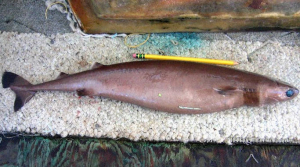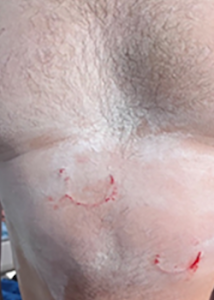
A University of Hawaiʻi at Mānoa faculty member’s personal interest in channel swimming has led to published research highlighting the rare interactions between cookiecutter sharks (Isistius brasiliensis) and humans, particularly among channel swimmers in Hawaiʻi. The study, led by Steven Minaglia, an associate professor of obstetrics and gynecology and women’s health at the University of Hawaiʻi at Mānoa John A. Burns School of Medicine and an avid channel swimmer, showed how environmental conditions can increase the likelihood of these attacks.

Cookiecutter sharks, known for their distinctive feeding method that leaves cookie-cutter-shaped wounds, are typically found in deep tropical and subtropical waters. Despite their small size, these sharks can pose a significant threat, although rarely. Of the seven reported cookiecutter shark attacks on humans worldwide, six occurred in Hawaiʻi, and five of those involved channel swimmers.
Finding the link
Minaglia’s study analyzed data from 1961 to 2023, covering 129 successful solo channel swims and five shark-related injuries. He discovered a link between these attacks and environmental conditions, particularly on moonless nights. The risk of shark attacks significantly increases during complete darkness compared to when the moon or sun is visible. Other factors, such as swim start times and the time of year, also correlate with the likelihood of an attack.

Minaglia’s study was prompted by his ongoing personal research on channel crossings in Hawaiʻi to determine optimal swimming conditions. He planned to swim the 26-mile Kaʻiwi Channel between Oʻahu and Molokaʻi in 2020, but was concerned because of a series of shark attacks among swimmers the previous year.
“When I noticed that five out of six shark bites occurred on moonless nights, I felt a duty to publish these important findings that can potentially improve safety for channel swimmers,” said Minaglia, who successfully swam the challenging Kaʻiwi Channel in 22-hours in October 2020 during a full moon. He noted the strong currents during full moons also made it a difficult swim.
Minaglia compiled an electronic database in 2018 with data from the Hawaiian Channel Swimming Association. His research is one of only three papers addressing cookiecutter shark attacks on live humans.
The study, supported by Queen’s University Medical Group where Minaglia serves as director of urogynecology and reconstructive pelvic surgery, is available as open access on PLOS One.
“I hope this research provides valuable insights into safe swimming practices for the global swimming community,” Minaglia said.

